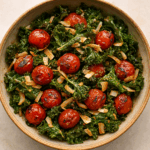
Kale can be tricky, but with a little know-how it becomes a surprisingly versatile ingredient.
From choosing the right leaves to prepping them properly, here’s what to keep in mind when making kale the star of your kitchen, and your salad.
Spring approaches and we’re almost ready to break up with our steadfast winter companions, the hearty brassicas. They’ve served us well, but we’ll soon have ample fresh local produce; tough leafed greens, sturdy root vegetables and produce from afar will no longer be our only options. That said, kale is enjoying a recent uptick in popularity and kale salad epitomizes this interesting (to me) turn of events. From garnish to culinary darling … who knew?
I’ve always been a huge fan of cooked kale; I often add it to soups and stews or sauté it with other greens like Swiss chard and spinach. It adds that unmistakable cruciferous tang and substance.
Consequently, it took me a while to give this substantial green a starring role in a salad. During my investigations over the last few years, I’ve encountered more than a few questionable attempts. The emperor’s new clothes often came to mind. However, it is possible to tame the beast should you wish to accept the challenge.
Maturity and size of leaves will determine the texture and taste to a large extent. Small young kale leaves are hardly distinguishable from other leafy salad greens while the larger, older, tougher leaves tend to be more suitable for cooking … or perhaps massaging? Yes, you heard me.
If you have time on your side and massaging raw kale doesn’t immediately appeal, you can dress your prepared greens with an acidic (vinegar, lemon juice) vinaigrette and just let it sit around for a bit. The acid will break down the fibre that makes kale so, well, chewy. Perfect for make-ahead work or school lunches and even picnics.
Still wondering about the massaging bit? Need that kale salad right now? There are different schools of thought here, but really you just have to rub the torn leaves, dressed or undressed, between your fingertips for a minute or two or until they become soft and wilted. Now you can add your salad ingredients and the rest of the dressing. Talk about getting to know your food.
Kale is tasty, healthy and relatively inexpensive. Commonly found varieties are curly kale, ornamental (white, purple or green) kale and dinosaur kale, sometimes called Tuscan kale. While it’s available year-round almost everywhere, a farmers’ market might ensure a more local product. Look for crisp, unblemished leaves with rich colour and moist, pliable stems. Keep your kale in a bag in the fridge but remember, the longer kale is stored, the stronger and more bitter it becomes.
To prepare larger leaves, cut or tear away the leaf from the centre stalk. Like spinach, kale can be a little gritty if it isn’t washed well. Wash several times in cold water and then use a salad spinner. Wet salad greens are anathema.
Warm Kale Coconut Tomato Salad
Ingredients
- 12 oz cherry tomatoes
- 4 tbsp olive oil
- 3 limes
- 1 tsp salt
- 1/2 tsp black pepper
- 12 oz curly kale, stalks removed
- 1/4 cup unsweetened dehydrated shaved coconut
- 1 tbsp soy sauce
- 1 tbsp grated fresh ginger
- 2 tbsp white miso paste
- 1 tbsp liquid honey
- 1 red serrano pepper, very finely minced, optional
Instructions
- Heat your oven to 450 F.
- Place the halved tomatoes on a sheet pan and toss with half the olive oil, salt, pepper, zest of 2 of the limes and juice of 1 lime.
- Roast the tomatoes for 15-20 minutes, until blistered and starting to colour.
- While the tomatoes are cooking, tear the washed and dry kale into pieces. Mix the kale with the coconut and soy sauce on another sheet pan. Put the kale in the oven with the tomatoes and cook for 5-10 minutes, or until the edges begin to crisp.
- In a small bowl, combine the grated ginger, miso, honey, hot pepper and juice of the remaining limes. Taste and adjust (more honey, more lime juice,salt, pepper, etc.).
- Toss the tomatoes with the kale in a larger bowl and drizzle the dressing over the top, a little at a time. If the tomatoes are very juicy you may not need it all. Serve warm.










Leave A Comment